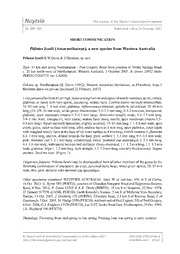
Ptilotus benlii (Amaranthaceae), a new species from Western Australia PDF
Preview Ptilotus benlii (Amaranthaceae), a new species from Western Australia
Nuytsia The journal of the Western Australian Herbarium 28:299-302 Published online 26 October 2017 SHORT COMMUNICATION Ptilotus benlii (Amaranthaceae), a new species from Western Australia Ptilotus benlii R.W.Davis & T.Hammer, sp. nov. Type. 15 km east along Northampton - Port Gregory Road from junction of Yerina Springs Road, c. 20 km north-west of Northampton, Western Australia, 3 October 2005, R. Davis 10952 (holo: PERTH 07200773; iso. CANB). Ptilotus sp. Northampton (R. Davis 10952), Western Australian Herbarium, in FloraBase, https:// florabase.dpaw.wa.gov.au/ [accessed 22 February 2017], Erect perennial herbs to 45 cm high. Stems arising from an underground woody rootstock, terete, ribbed, glabrous, or rarely with very sparse, ascending, nodose hairs. Cauline leaves narrowly oblanceolate, 10-60 mm long, 1-4 mm wide, glabrous. Inflorescences terminal, spiciform, cylindrical, 20-48 mm long, (25-)28-34 mm wide, white-green. Bracts ovate, 5.5-7.1 mm long, 3-3.2 mm wide, transparent, glabrous; apex mucronate (mucro 0.3-0.5 mm long). Bracteoles broadly ovate, 5.5-7.7 mm long, 3.8-5 mm wide, transparent, with sparse, nodose hairs along midrib; apex mucronate (mucro 0.3- 0.5 mm long). Tepals narrowly lanceolate, slightly in-rolled, 13-16 mm long, 1.1-1.8 mm wide; apex entire, green; outer surface with long, silky, nodose hairs to 5 mm long, apex glabrous; inner tepals with marginal woolly hairs at the base of the inner surface to 4 mm long. Fertile stamens 5 , filaments 6.3-7 mm long, uneven, dilated towards the base, pink; anthers 1-1.5 mm long, 0.5-0.6 mm wide, pink. Staminal cup 2-2.1 mm long, symmetrical, lobed. Staminal cup appendages 2-2.3 mm long, 0.4-0.6 mm wide, with sparse hairs on both surfaces. Ovary obconical, 1.1-1.2 mm long, 1.1-1.3 mm wide, glabrous. Stipe 1-1.2 mm long. Style straight, 5.5-7.3 mm long, centrally fixed to ovary. Stigma capitate. Seed not seen. (Figure 1) Diagnostic features. Ptilotus benlii may be distinguished from all other members of the genus by the following combination of characters: an erect, perennial herb; large, white-green spikes, 28-35 mm wide; five, pink stamens with staminal cup appendages. Other specimens examined. WESTERN AUSTRALIA: track W of rail-line, 600 m S of Canna, 16 Oct. 2013, G. Byrne 589 (PERTH); junction of Chandler-Nungarin Road and Talgomine-Reserve Road, 8 Nov. 2014, R. Davis 12505 & K.R. Thiele (PERTH); 18 km S of Youanmi, 22 Nov. 1978, H. Demarz D 7256 (CANB, PERTH); Garth Kowald’s Avenue, 2 km E of Mullewa Shire boundary, Tardun, 13 Oct. 2007, J. Docherty 453 (PERTH); Ellendale Road, 3.5 km S of Ramsay Road, E of Greenough, 5 Dec. 2005, M. Hislop 3550 (PERTH); northern end of Hutt Lagoon, NE of Port Gregory, 6 Nov. 2008, G.J. Keighery 17476 (PERTH); Lot3157, Isseka Road East, Northampton, 25 Oct. 1999, I. B. Shepherd 198 (PERTH). Phenology. Flowering from mid-spring to late spring. Fruiting from late spring to early summer. © Department of Biodiversity, Conservation and Attractions 2017 ISSN 2200-2790 (Online) https://florabase.dpaw.wa.gov.au/nuytsia/ ISSN 0085-4417 (Print) 300 Nuytsia Vol. 28 (2017) Figure 1. Ptilotus benlii. A - flowering plant in situ showing the erect habit and green-white flowers; B - flower, showing the characteristic pink filaments and anthers. Images from R. Davis 10952. Photographs by R. Davis. R.W. Davis & T. A. Hammer, Ptilotus benlii (Amaranthaceae), a new species from WA 301 Distribution and habitat. Ptilotus benlii occurs from west of Northampton, south-east to Nungarin in the central wheat-belt, and east to the Murchison bioregion near Youanmi Station, 125 km south-east of Mt Magnet (Figure 2). It is often found growing on red or yellow clayey sands in open Acacia scrub with A. rostellifera or in open mallee woodlands. Conservation status. Ptilotus benlii can be found over a wide area on a range of habitats and appears not to be under any immediate threats; however, it is under-collected to the far east and south-east of its range. Etymology. The epithet acknowledges the significant contribution of German botanist Gerhard Beni (1910-2001) to the taxonomy of Ptilotus R.Br. His work on the genus spanned 40 years, during which time he described upwards of 30 species and numerous infraspecific taxa, and prepared a draft manuscript for the genus for Flora of Australia. Notes. The chloroplast matK and nuclear ITS markers have been sequenced for P. benlii for a forthcoming PhD thesis (Hammer, in prep.). A preliminary phylogeny including this species has placed it as sister to P. esquamatus (Benth.) F.Muell., in a basal position to the LP. drummondii clade’ (including P. drummondii (Moq.) F.Muell., P. schwartzii Tate, P. aphyllus Beni and P. calostachyus F.Muell.). Ptilotus benlii shares the character of staminal cup appendages with these species, but can be readily distinguished based on its larger, green-white flowering spikes and bright pink filaments and stamens. Ptilotus esquamatus differs from P. benlii in having pink spikes, bright orange staminal cup nectaries, and in lacking staminal cup appendages. All other species in this group have pink flowers, or if green, then much smaller spikes. ^/leekatharra A #Kalbarri ^/lount Magnet (cid:9650) Geraldton (cid:9650) Port Denison (cid:9650) • J”hree Springs (cid:9650) A Southern Cross ^Gingin ^lerredin ^Northam #Perth 0 75 150 km I-1-1 Figure 2. Distribution of Ptilotus benlii (A) in Western Australia. 302 Nuytsia Vol. 28 (2017) Acknowledgements The authors acknowledge the staff of the Western Australian Herbarium for their assistance and the support of the Forrest Research Foundation. Robert W. Davis1 and Timothy A. Hammer2 ‘Western Australian Herbarium, Department of Biodiversity, Conservation and Attractions, Locked Bag 104, Bentley Delivery Centre, Western Australia 6983 2School of Biological Sciences, Faculty of Science, The University of Western Australia, 35 Stirling Highway, Crawley, Western Australia 6009 ‘Corresponding author, email: [email protected]
